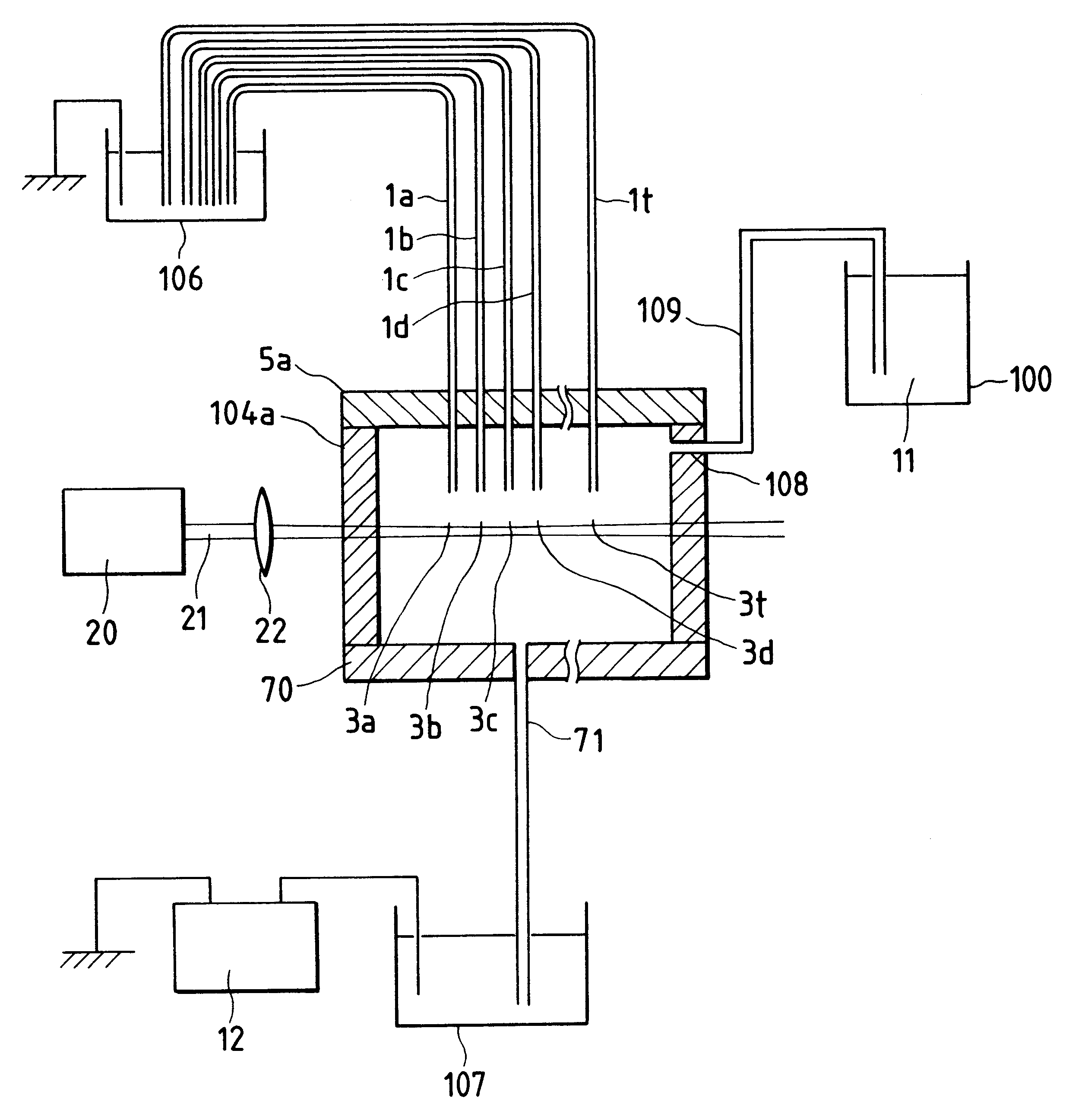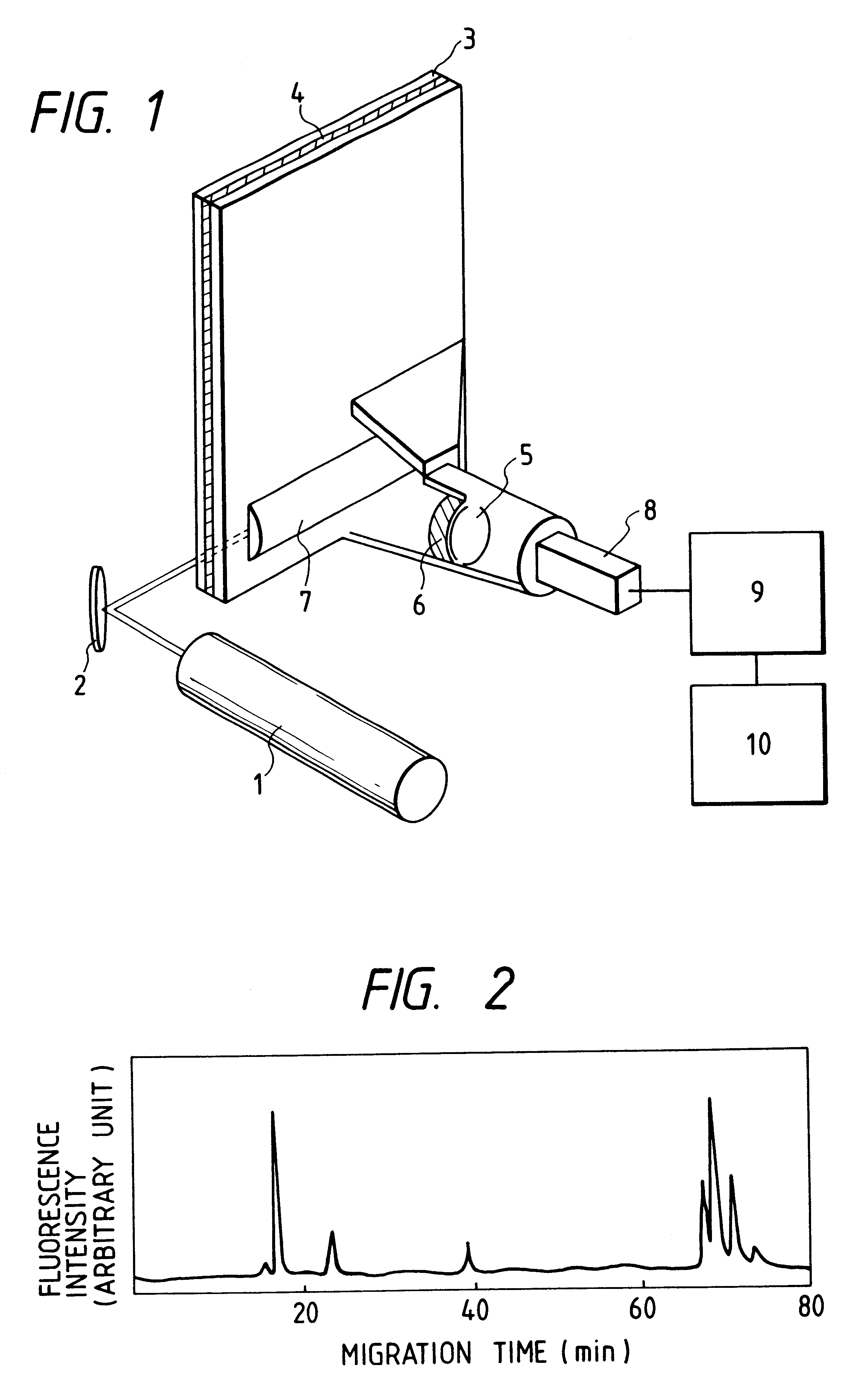DNA detector and DNA detection method
a detector and dna technology, applied in the direction of fluid pressure measurement, liquid/fluent solid measurement, peptide measurement, etc., can solve the problems of reduced detection sensitivity, high background level, and insufficient consideration of simultaneous processing of two or more samples, and achieve high-efficiency photodetecting
- Summary
- Abstract
- Description
- Claims
- Application Information
AI Technical Summary
Benefits of technology
Problems solved by technology
Method used
Image
Examples
first embodiment
of the present invention will be described with reference to FIGS. 1 and 2. FIG. 1 is a schematic view representing the detector. Light emitted from the 594 nm He--Ne laser 1 irradiates the electrophoresis separation gel plate 4 from the side. After being collected by the cylindrical lens 7, the fluorescence emitted from the linearly irradiated portion is filtered out by the band pass filter 6, and forms images on the line sensor or secondary detector 8 through the lens for image formation 5. Filter 6 is a 6-cavity multilayer interference filter with a diameter of 50 mm, and transmittances for light having wavelengths of 594 nm, 600 nm, 610-630 nm and 640 nm are 10.sup.-4, 10.sup.-2, 0.6 or more, and 0.01 or less, respectively.
The concentration of the acrylamide gel constituting the gel plate 4 (concentration of the total quantity of monomer) is 4 to 6 percent (g / cc). When irradiated by the He--Ne laser with the wavelength of 594 nm, the background fluorescence from the gel has the ...
embodiment 2
In the present Embodiment, DNA fragments labeled by fluorescence are separated by electrophoresis and detection is made by fluorescence. The following describes the case of using Texas Red (Sulforhodamine 101, maximum emission wavelength of 615 nm) as labeling fluorophore. The DNA fragments as samples are labeled by fluophores. DNA fragments labeled by fluorophores are prepared by DNA polymerase reaction, using the primer labeled by fluorophore according to the well-known dideoxy sequencing method invented by Sanger and his colleagues. The details of the method of preparing samples according to Sanger's dideoxy sequencing method are described in the Embodiment 3.
Firstly, the apparatus configuration will be described FIG. 3 shows the electrophoresis region and laser irradiation system of the electrophoresis apparatus according to the present Embodiment. FIG. 4 represents the fluorescence detection system of the electrophoresis apparatus. The electrophoresis apparatus includes an arra...
embodiment 3
The following describes the DNA sequence determination method using the apparatus introduced in Embodiment 2. DNA fragments labeled by fluorophores are prepared by DNA polymerase reaction, using the primer labeled by fluorophore according to the well-known dideoxy sequencing method invented by Sanger and his colleagues. The primer bonded with Texas Red (Sulforhodamine 101, maximum emission wavelength of 615 nm) is used as primer. Firstly, the labeled primer is added to the single-strand DNA and annealed, so that labeled primer is bonded to the single-strand DNA. This reaction solution is divided into four parts, which are subjected to DNA polymerase reactions corresponding to A, C, G and T, respectively. That is, four types of deoxynucleotide triphosphates (dATP, dTTP, dCTP and dGTP) and ddATP which will be a terminator are added to the single-strand DNA bonded with labeled primer to cause DNA polymerase reaction. The above procedure provides DNA fragments labeled by fluorophores ha...
PUM
| Property | Measurement | Unit |
|---|---|---|
| wavelength | aaaaa | aaaaa |
| wavelength | aaaaa | aaaaa |
| wavelength | aaaaa | aaaaa |
Abstract
Description
Claims
Application Information
 Login to View More
Login to View More - R&D
- Intellectual Property
- Life Sciences
- Materials
- Tech Scout
- Unparalleled Data Quality
- Higher Quality Content
- 60% Fewer Hallucinations
Browse by: Latest US Patents, China's latest patents, Technical Efficacy Thesaurus, Application Domain, Technology Topic, Popular Technical Reports.
© 2025 PatSnap. All rights reserved.Legal|Privacy policy|Modern Slavery Act Transparency Statement|Sitemap|About US| Contact US: help@patsnap.com



